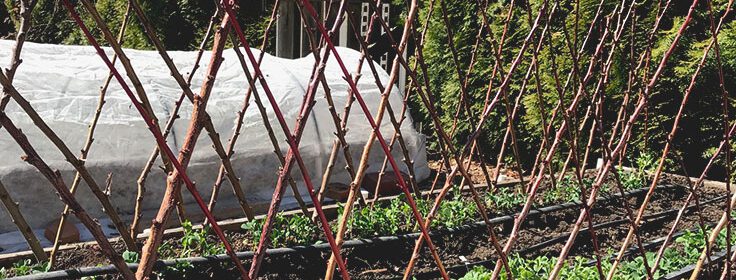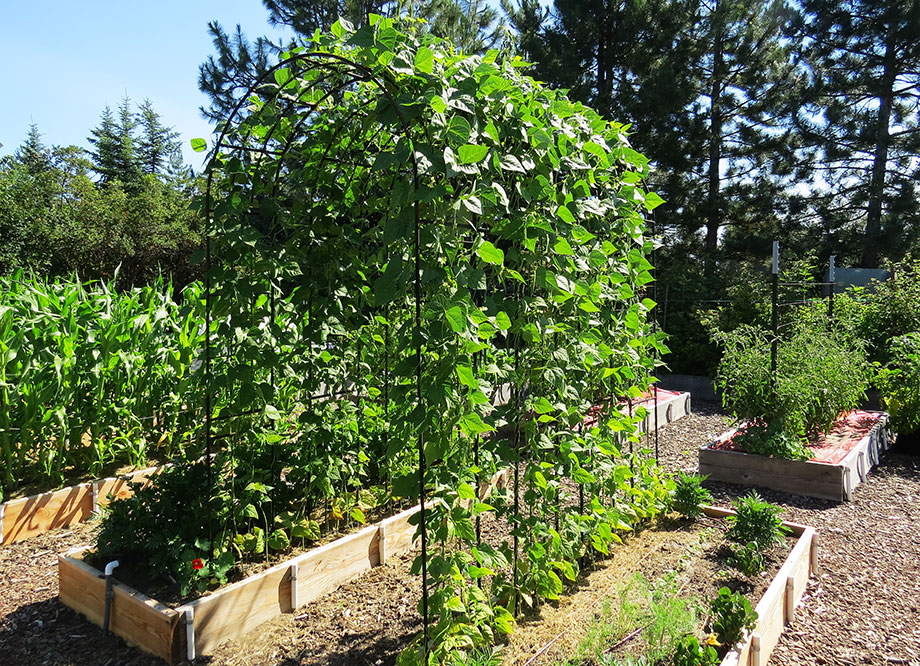Apr. 25 Column: Plant Supports

For this week’s column, I wrote about the plant supports we use in our garden. I receive a lot of questions about them and I’m also hoping they’ll provide some inspiration. You can read my column in today’s edition of The Spokesman-Review: Give plants support for a more productive garden. (or you can read it at the bottom of this post)
Plant supports are also the topic of this week’s video. I discuss our livestock panel arbor and the crowd-pleasing pole bean arbor. I share examples of tomato supports, decorative trellises, and making plant supports with natural materials from your garden. All of these are sure to get your creative juices flowing!
What I love most of all is that growing plants vertically adds a lot of interest to the garden. For two years, I’ve grown melons, pie pumpkins and winter squash up and over a livestock panel arbor. I could just let them sprawl all over the place on the ground but this looks cool. The garden looks tidier, too.
There’s one detail I inadvertently neglected to mention about the livestock panel arbor. We used a bolt cutter to clip off the wire at either end of each livestock panel. That provided us with spikes to push into the ground. Once the panels were in place, we drove in metal fenceposts on the outsides of each panel. Those support and stabilize them.
Plant supports video:
Plant supports column:
by Susan Mulvihill
Plant supports are an important element for every vegetable garden. They keep plants off the ground, increase productivity and even add interest to what might otherwise be a ho-hum garden.
Pole beans are one of my favorite crops. Because the vines are very long, I recommend providing them with supports that are at least 6 feet tall. About 12 years ago, I switched from using makeshift supports to a series of four trellises to create a bean arbor than spans the pathway between two raised beds. This provides excellent support and adds a delightful vertical element to the garden. It also allows me to stand underneath the arbor while harvesting beans on hot summer days.
Tomato plants grow best and produce well when they are provided with sturdy supports. If allowed to sprawl on the ground, the plants are more susceptible to disease pathogens in the soil. In addition, tomatoes will ripen better when they have more access to sunlight and good air circulation.
I used to grow mine in tomato cages. In the early days, I would purchase those small, flimsy cages sold in garden centers. Once the plants grew to a certain point and were heavy with fruit, they would flop over onto the soil, making me wonder why I bothered in the first place. Thank heavens garden centers now carry sturdier cages. Even so, it’s always important to attach each cage to a strong stake.
After a few years, we made some heavy-duty tomato cages from leftover 47-inch-tall field fence, which we always supported with stakes. The fencing has large openings for harvesting tomatoes or doing a bit of pruning.
I’ve since switched to growing my tomato plants along a 4-foot by 8-foot sheet of concrete-reinforcing wire that is secured to metal stakes. This is an easier method for supporting the plants and even allows me to squeeze an extra plant or two into the bed.
Pea vines also need vertical supports. For years, I would grow them up netting or wire grids. While they worked fairly well, neither was very attractive and both were a nightmare to clean up at the end of the season.
Four years ago, I started supporting peas with pruned branches from our small orchard. In addition to the branches being free, this method allowed me to tap my creative side by placing the branches in interesting patterns. My past visits to English gardens continue to provide plenty of inspiration for this.
In 2019, I decided it would be fun to grow winter squash, cucumbers, melons and small pumpkins up and over an arch, as a means of imitating the bean arbor concept. Instead of purchasing more trellises, Bill and I started with two wire panels known as livestock panels. We carefully maneuvered each one into an arch through the use of ratcheting tie-down straps, moved them into place and pounded in four heavy-duty metal fence posts on the outside of each arch to prevent them from straightening out. At that point, it was safe to remove the straps.
The vines initially required a little guidance on growing vertically but once they got the idea, they quickly worked their way up the arbor, rather than sprawling over pathways and neighboring beds.
There are a lot of fun, creative ways to support sprawling types of veggie crops. Sometimes it helps to think outside the box to make a food garden a bit out of the ordinary.

